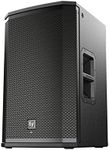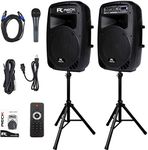Buying Guide for the Best Portable Pa Systems
Choosing a portable PA (public address) system can make a big difference in how clearly and effectively you can communicate or play music in various settings, such as events, presentations, or performances. The right system should be easy to transport, simple to set up, and powerful enough for your needs. To find the best fit, it's important to understand the main features and specifications that affect performance, portability, and usability.Power Output (Wattage)Power output, measured in watts, tells you how loud the PA system can get. Higher wattage means the system can project sound over a larger area or to a bigger audience. For small gatherings or indoor use, lower wattage (20-50W) is usually enough. Medium events or outdoor use may need 50-150W, while large crowds or open spaces might require 150W or more. Think about the size of your typical audience and venue to decide how much power you need.
Portability (Weight and Size)Portability refers to how easy it is to move and set up the PA system. Lighter and more compact systems are easier to carry, especially if you need to transport them frequently or set up quickly. Some systems come with handles or wheels for added convenience. If you’ll be moving the system often or using it in different locations, prioritize lightweight and compact designs. If it will mostly stay in one place, size and weight may be less important.
Battery LifeBattery life indicates how long the PA system can operate without being plugged in. This is crucial if you plan to use the system outdoors or in places without easy access to power outlets. Shorter battery life (2-4 hours) may be fine for brief events, while longer battery life (6-12 hours or more) is better for all-day use. Consider how long your typical events last and whether you’ll have opportunities to recharge.
Input OptionsInput options determine what devices or microphones you can connect to the PA system. Common inputs include microphone jacks, instrument inputs, Bluetooth, USB, and auxiliary (AUX) ports. More input options give you greater flexibility to connect different sources, such as microphones, guitars, phones, or laptops. Think about what you’ll be plugging in most often and make sure the system supports those connections.
Sound QualitySound quality is about how clear and balanced the audio is when played through the system. Good sound quality ensures your voice or music is easy to hear and pleasant to listen to. Some systems have features like equalizers or tone controls to help you adjust the sound. If clarity and richness are important for your use (like music performances), pay attention to reviews or try to listen to the system before buying.
Wireless FeaturesWireless features include built-in Bluetooth for streaming music and wireless microphones for greater freedom of movement. Bluetooth is useful if you want to play music from your phone or tablet without cables. Wireless microphones are helpful for presenters or performers who need to move around. Decide if these features are important for your events and check if the system includes them.
Durability and Build QualityDurability refers to how well the PA system can withstand regular use, transport, and occasional bumps or drops. Systems with sturdy cases and quality materials last longer, especially if you’ll be using them outdoors or moving them often. If you expect heavy use or rough handling, look for systems known for their robust build.















